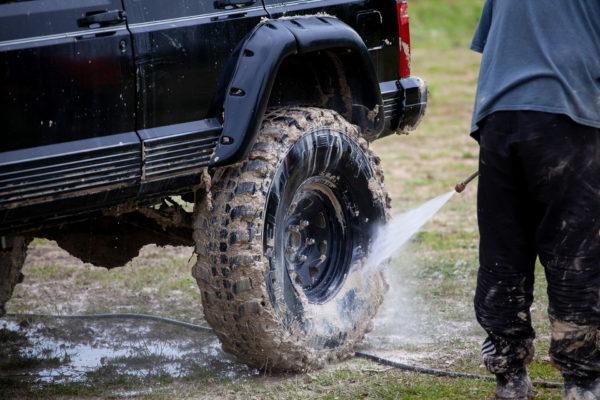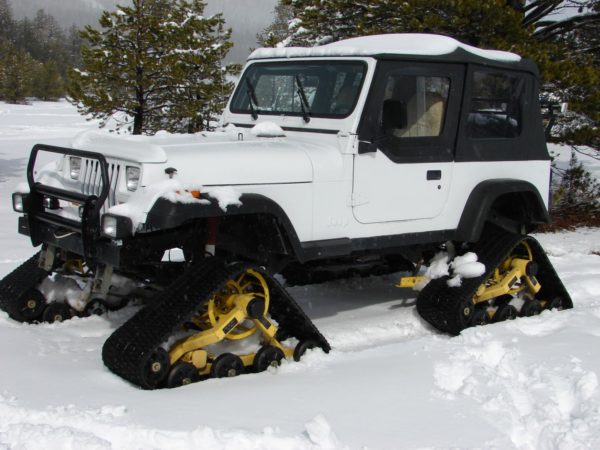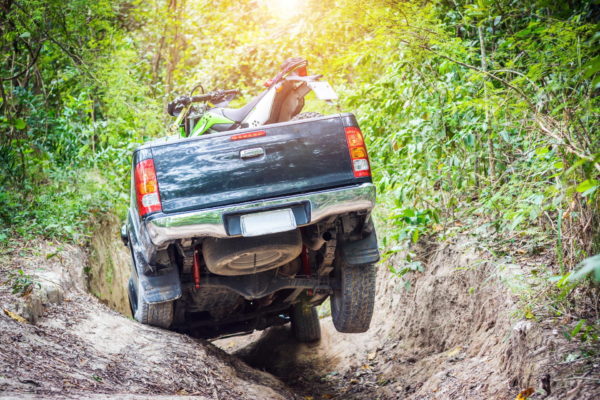Off-road vehicles are always a bit of a compromise to allow them to drive on-road, too, but there are a set of features that you should look for which will improve your experience of driving on rough, muddy, rutted roads.
All-wheel-drive (AWD) or four-wheel-drive (4WD or 4×4)
Because of the differential, a two-wheel-drive vehicle is really only driving through one wheel, and that will cause you to get stuck very quickly. Four-wheel-drive vehicles usually have a front axle with a differential and a rear axle with a differential. This rear differential can be slightly different and we’ll get to this later, but the upshot is that, at minimum, you’ll now have at least one wheel at the front and one wheel at the rear to help keep you moving.

A low-range option in the gearbox is desirable.
Off-road tyres and wheels
In general, the wider the grooves in the tyres and the deeper and more angular the blocks, the better the grip will be on very loose or very muddy surfaces, but the worse it will be on a tarmac road (it’ll be much noisier and will have less grip). The deep tread pattern will bite into the surface and provide some purchase to keep you moving. The grooves are also designed to evict the mud rather than retain it; road-going tyres hold mud, effectively making them slicks.

Off-road tyres have a higher sidewall (the height of the tyre in relation to the diameter of the wheel). This enables the tyre to run at a lower pressure (therefore more of the tyre is in contact with the road) and it will absorb and deform to difficult surfaces.

Wheels for off-road vehicles are often slightly larger (within the limits of the suspension, which we’ll get to in a moment) so that you can have more ground clearance.
Specialist off-road suspension
There are too many configurations to go into here, and you’ll see that serious off-roaders have jacked-up suspension to give extra ground clearance and wheel articulation. Taller suspension will give you better approach and departure angles when driving on a slope, and more flexibility with ramp breakover angles and when driving in ruts (i.e. you won’t get beached as easily).
When looking for your own vehicle, look for good quality coils and the ability to switch suspension modes.
The more tuned to off-road driving your suspension is, the worse it will be on the road, though.

Electronic driver aids
Modern SUVs and pickups have technology such as hill descent mode and various options for changing the suspension and engine characteristics to deal with snow, mud, sand and so on.
Rescue and recovery equipment
The bare minimum you’ll need is a spare tyre, a towing strop and a spade, but more gear is better – check on off-road forums for recommended lists depending on the type of driving you’re doing.
If you’re going for the hardcore options, a winch is recommended.

Bullbars
Bullbars will help protect your bumpers and paintwork. They can be useful to nudge obstacles like trees and branches out of the way.

Snorkel
A good snorkel will raise the wading depth of your vehicle. With a snorkel, the engine will be able to be mostly submerged and will keep doing as the snorkel provides the air for combustion of fuel.
Lockable differential
The differential enables one wheel to spin while the other isn’t. This is essential for allowing your vehicle to corner smoothly, but it’s not desirable when you’re off-road because if one wheel loses grip, that will be the wheel that will spin. A lockable diff or a limited slip diff (LSD) will ensure that power is provided through both wheels on the axle.
Some vehicles also have a centre differential which can be locked.
Most new 4WD or AWD vehicles have automatic distribution of power to wheels that need it.
Torquey motor
If you don’t have grunt low-down, then you’ll lack control at low speed. Larger diesel engines work well.
Rated recovery points
You will get stuck and at some point you’ll need to be pulled out of the mire. Factory-supplied tie-down points are not designed to pull your motor out of a boggy situation. You also should never try to pull your vehicle by running a strap around the towball (it can shear off and then it becomes a missile) or around bullbars (they bend too easily).
Communications aids
A long-range CB radio can help if you’re out of cellphone coverage. A personal locator beacon is a good idea if you’re in the middle of nowhere and have a crisis.
